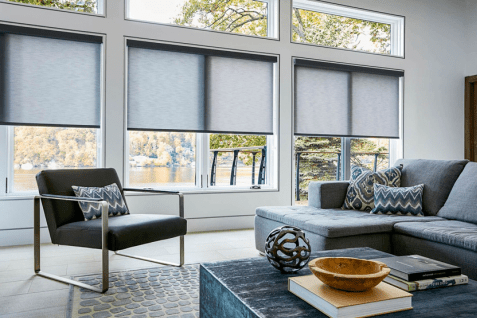Adding window coverings to your home can add a designer look to your rooms and spaces and if done correctly can also instantly improve the look and feel of your rooms. Blinds are an excellent way to add both style and function to your windows, however, there are lots of fabrics and styles from which to choose and this can make deciding on the right fabric difficult.
Choosing the wrong type of blind fabric or material could leave you with a window covering that does not provide the look or function that you were aiming for. We have put together this practical little guide to help you ask the right questions when shopping around for the right fabric for your blinds.
Consider the Climate of Where You Live
Considering the climate where you live, is probably the most important thing to think about first when it comes to choosing fabric for your blinds, which is why we put it at the top of our list. We know how hot it can get on the Sunshine Coast, which makes blinds an essential window covering for every home.
For our warmer climate, the goal will most likely be to keep your home cool, keeping energy costs low while maintaining comfort and style. During cooler months, you may want to keep rooms warmer with minimal energy and gas usage as well. Having the right type of blinds installed can help control the temperature in your home and keep your monthly costs under control.
Factor in Your Homes’ Level of Exposure
Next to climate, the level of exposure to the sun and other extreme temperatures also has a major bearing on the type of blinds you decide to install. Why? Well, let’s say your master bedroom is facing the direction of the sunrise and your kitchen is facing the side where the sun sets; you probably want a material or fabric that completely blocks out the bright morning sun—especially for those mornings where you want to sleep in! Also, are there trees and shade surrounding your home? Or, are there trees on one side of your home, leaving the other side completely exposed to sunlight? These are all things that should be taken into account when choosing blinds for your home.
In contrast, your kitchen will most likely not require the same type of material or coverage as your bedroom will. For example, a light fabric that filters the light rather than completely blocking it out could be more appropriate in this scenario. With all this in mind, you want to make sure the blinds in your home provide a high level of UV protection from harmful rays to protect your homes flooring and furniture from fading.
A high-quality fabric will make all the difference with the effectiveness of how your blinds control temperatures and exposure to light to your rooms.
Think about the Function of Your Blinds
Similar to exposure, function is also an important aspect of choosing the right blinds style and fabric. Darker fabrics are an excellent choice for reducing glare but absorb more heat compared with lighter fabrics. Lighter fabrics reflect more light, which is why they absorb less heat.
If you want more privacy in a room, then a tighter or closed fabric weave is the best choice. Whereas, open weave fabrics let you enjoy the beautiful surroundings and views while still filtering some of the light that could come glaring into your home at certain times of the day.
When it comes to the function of your blinds and what a room will be used for, the fabric you ultimately choose will determine how well the blinds do their job. You should consider enlisting the help of professionals to provide you with expert advice as to what works best for your area and the different rooms in your home. They will factor in everything before offering solutions and can answer your questions about what to do and what not to do along with the pros and cons associated with each option.
Consider the Room
It’s important to consider the room for which you would like to install blinds. Not all blinds fabrics are suitable for all rooms. For example, wet rooms or rooms with more moisture can limit your choices due to the possibility of being damaged by moisture. It’s best to consider synthetic and man-made materials to avoid any possible damage. Your local blinds dealer should be able to consult with you on the best options for rooms with more moisture like your bathroom and kitchen area.
Keep Your Own Personal Style in View
An important aspect to include throughout your decision-making process for the fabric and/or style of your blinds should be your own personal style. After all, it is your home and you’re the one who ultimately has to live in it. Lucky for homeowners, there are many different types of styles, colours, and fabrics to choose from. This can be a bit of a daunting task for some, but with all of the options available to consumers, it should be relatively easy to find and narrow down your options to suit your own personal style as well as the look and design you are trying to achieve.
Understanding available style options will also help you make the right decision for your windows and home. Below is a breakdown along with the function and features of the most common fabric blinds styles available for purchase.
Main Types of Fabric Blinds
There are many different types of blind fabrics on the market. Some of the most popular types of fabric window coverings include:
Roller Blinds
Roller blinds are made with a fabric that has been stiffened to make it easier for the blinds to be rolled up onto a tube at the top of the blind when they are not in use. Roller blinds are still one of the most popular window furnishings today due to these blinds being simple, easy to operate, durable and can be made with a huge choice of fabrics.
Roman Blinds
Roman blinds offer a sophisticated and stylish look while blocking out light and provide privacy as well. They are usually made of a soft fabric but do come in other style variations as well. When fabric roman shades are raised they gather in pleats and when they are down, they lie flat against your window. Romans can be made with or without battens which can provide a unique look.
Panel Glide Blinds
Unlike roller blinds and roman blinds, panel glide blinds are made up of flat panels of fabric which slide across the window rather than rolling up. Ideal for large windows, glass sliding doors and partitioning rooms.
These flat panels can be opened from the middle or stacked to one side when they are open, and can also be made with or without battens.
Vertical Blinds
Vertical blinds are a very practical and economical choice and are one of the most versatile blinds for adjusting light into a room. The vertical blind comprises of material strips that hang down vertically that can be rotated with a wand to provide light control and privacy, and then simply pulled across to one side to fully open or close the blind. When closed, the blinds overlap one another to keep the light from coming in.
Types of Fabric
When choosing fabric for your blinds, you should consider the functional purpose of your window coverings, such as light control, privacy, and if you wish to have a clear view through the blind. You may also require different levels of privacy in different parts of your home.
For this reason, we have outlined the three most common types of window covering fabrics: Blockout, Translucent, and Screen:
Blockout
Block out fabrics (also known as ‘black out’ fabrics) are made with a coating that stops light from piercing through, perfect for blocking nearly all natural light from entering a room to provide you with complete privacy. This type of fabric offers you maximum protection from heat, glare and UV rays as well as maintaining excellent insulation.
Translucent
Translucent fabrics (also known as ‘light filtering’ fabrics) gently filter natural light into your home. An ideal fabric choice for brightening up your home whilst also ensuring both day and night time privacy.
Screen
Screen fabrics (also known as ‘sunscreen’ or ‘transparent fabrics’) are perfect for providing you with a clear view to the outside whilst still letting natural light into your home and providing daytime privacy.

Mixing Fabric Selections
To utilise the advantages of each fabric, you can easily combine the translucent or screen fabrics with a blockout fabric. Double blinds (also known as ‘day and night’ blinds) include two different types of fabric blinds on a single bracket for total light control.
By alternating between the blockout blind for privacy and darkness, to the translucent or screen fabric for filtered natural light or a clear outside view, you can achieve the best of both worlds.
For more information or a free measure and quote please contact us at BSA Direct. We understand the importance of choosing the right fabrics for different applications within your home and will ensure that your goals are achieved from the blinds installed in your Sunshine Coast home.

About Us
We love helping our customers across the Sunshine Coast choose their window furnishings!

Gallery
Looking for some ideas and inspiration for your next project?






















